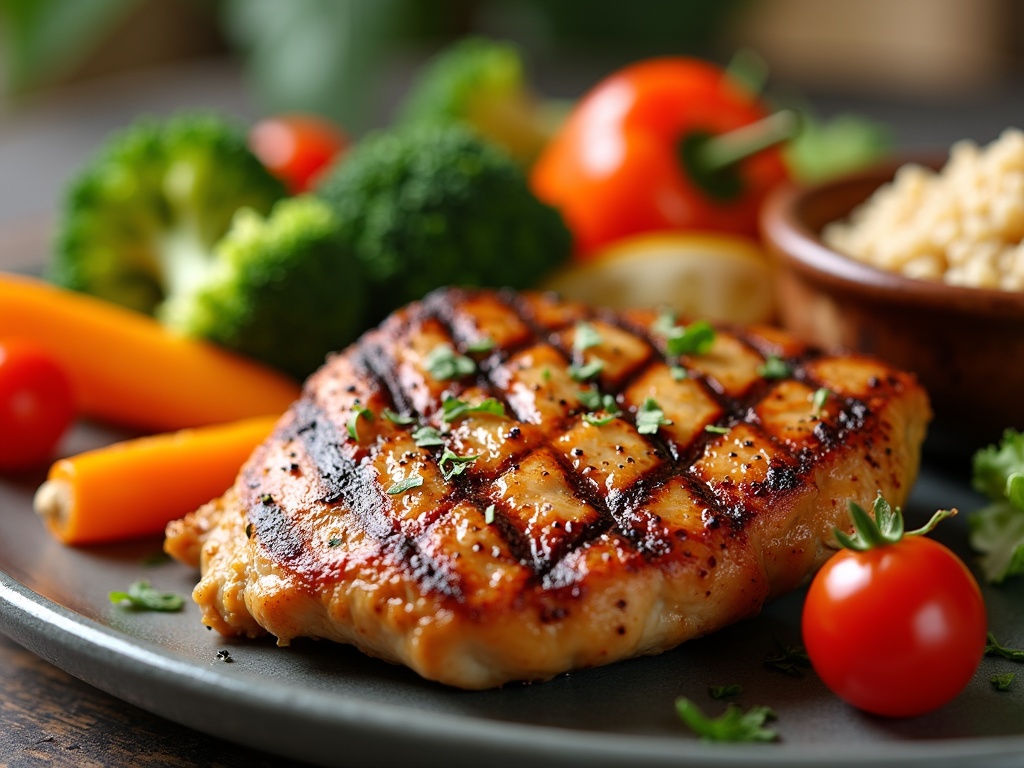Chicken steak offers an impressive nutritional profile with more protein and significantly less fat than beef steak, making it an ideal choice for health-focused eaters. This adaptable protein option contains 31 grams of protein per 100-gram serving while having only 3.6 grams of total fat, delivering excellent nutrition at just 165 calories.
Find In This Article
Key Takeaways
- Chicken steak contains more protein (31g per 100g) than beef steak (28g) while providing fewer calories (165 per 100g) and much less fat (3.6g vs 20g).
- Proper cooking requires reaching an internal temperature of 165°F for safety, with marinating for 30 minutes to 2 hours delivering optimal flavor.
- The chicken steak market is growing at a CAGR of 4% (2021-2028), driven by consumers seeking healthier protein alternatives.
- Free-range and organic chicken varieties offer superior nutritional profiles with higher omega-3 fatty acid content.
- Quality chicken steak should have uniform pink coloring, a firm texture that springs back when pressed, and no dark spots or bruising.
What Makes Chicken Steak a Healthier Choice
Chicken steak offers impressive nutritional benefits that make it a smart protein choice for health-conscious diners. I’ve found that many people overlook chicken steak when considering protein options, but its nutritional profile deserves attention.
Superior Protein with Fewer Calories
Chicken steak packs a serious protein punch with 31 grams of protein per 100 grams, which actually exceeds the 28 grams found in a comparable serving of beef steak. This makes it an excellent option for building and maintaining muscle mass. What’s even more impressive is that chicken steak delivers this protein boost at just 165 calories per 100-gram serving.
The fat content is where chicken steak truly shines as a healthier alternative. It contains only 3.6 grams of total fat per 100 grams, dramatically less than the 20 grams typically found in beef steak. This lower fat profile makes chicken steak recipes ideal for anyone managing their weight or fat intake without sacrificing protein.
Nutrient-Rich Profile
Beyond just protein, chicken steak offers a range of essential nutrients that support overall health:
- Rich in B vitamins, particularly B3 (niacin) and B6, which support energy production and brain function
- High in phosphorus, important for bone health and cellular function
- Excellent source of selenium, a powerful antioxidant that supports immune health
- Lower saturated fat content helps maintain healthy cholesterol levels
I’ve noticed that free-range and organic chicken varieties tend to offer even better nutritional profiles, with higher omega-3 fatty acid content. These healthy fats can help reduce inflammation and support heart health.
The nutrient composition makes chicken steak particularly beneficial for active individuals. The protein content supports muscle growth and repair, while the B vitamins aid in energy metabolism during workouts and recovery. For those looking to vary their chicken intake, simple chicken breast recipes and chicken chow mein provide tasty alternatives with similar nutritional benefits.
By choosing chicken steak over beef options, you’re getting more protein per calorie and significantly less fat—all while enjoying a versatile meat that can be prepared in countless delicious ways.

Perfect Your Chicken Steak Cooking Technique
Mastering the art of cooking chicken steak doesn’t have to be complicated. I’ve learned through years of cooking that a few key techniques make all the difference between dry, flavorless meat and juicy, flavorful chicken that impresses everyone at the table. The right cooking method can transform even budget-friendly cuts into memorable meals.
Temperature and Timing Essentials
Getting the temperature right is non-negotiable when cooking chicken. The internal temperature must reach 165°F for safe consumption – this isn’t just a suggestion but a food safety requirement. I always keep a reliable meat thermometer in my kitchen drawer because it’s the only foolproof way to know when chicken is perfectly cooked without cutting into it and losing those precious juices.
Marination is another game-changer for chicken steak. I’ve found that marinating for 30 minutes to 2 hours delivers optimal flavor without breaking down the meat’s texture. Any less time and the flavors don’t penetrate deeply enough; any more and you risk mushy chicken. A simple marinade of olive oil, lemon juice, garlic, and herbs can transform ordinary chicken breast recipes into extraordinary meals.
Cooking Methods for Perfect Results
Different cooking techniques bring out unique qualities in chicken steak:
- Grilling enhances flavor while maintaining moisture, creating those distinctive char marks that add smoky depth. I keep the grill at medium-high heat and only flip the chicken once to develop perfect grill marks.
- Pan-searing creates a crispy, golden exterior while keeping the inside juicy. This method works beautifully for thinner cuts like chicken fried steak, where that contrast between textures makes every bite exciting. The secret is getting your pan properly hot before adding the chicken, then leaving it undisturbed for several minutes to develop that perfect crust.
- Slow cooking tenderizes tougher cuts, breaking down connective tissues and creating fall-apart tenderness. This method transforms economical cuts into rich, flavorful dishes that taste like you spent hours in the kitchen. Using slow cooking techniques, I can turn simple chicken thighs into the base for an incredible chicken pie recipe that’s both comforting and impressive.
When slow-cooking chicken steak, it’s best for:
- Hearty stews where the chicken can absorb all the flavors of vegetables and herbs
- Casseroles that benefit from the chicken’s released juices
- Meal prep situations where you want tender, flavorful chicken to use throughout the week
- Creating rich chicken stock from the bones after enjoying the meat
For weeknight dinners, I often turn to quick-cooking methods like stir-frying chicken strips for a homemade chicken chow mein recipe or layering thin slices in a chicken lasagna for a family-friendly meal.
Each technique brings something special to chicken steak, and mastering them all gives you incredible flexibility in the kitchen. I’ve found that matching the cooking method to both the cut of chicken and the final dish I want to create makes all the difference in achieving restaurant-quality results at home.
Must-Try Chicken Steak Recipes
Looking for exciting ways to prepare chicken steak? I’ve compiled some versatile recipes that will transform this protein-packed cut into memorable meals. These options range from light and zesty to rich and comforting.
Flavorful Variations for Every Taste
The Lemon Herb Grilled chicken steak has become my go-to for summer gatherings. I combine fresh lemon juice with minced garlic and a handful of chopped herbs like rosemary, thyme, and parsley. After marinating the chicken steaks for at least 30 minutes, they develop an incredible depth of flavor that pairs perfectly with a simple side salad.
For a fun twist on taco night, chicken steak tacos make an exceptional choice. I slice grilled chicken steak into strips and serve them in warm corn tortillas with fresh toppings. The key ingredients that make these tacos stand out include:
- Ripe avocado slices or homemade guacamole
- Bright, chunky salsa (red or green works beautifully)
- Fresh cilantro leaves
- A squeeze of lime juice
- Thinly sliced radishes for crunch
On busy weeknights, I turn to stir-fried chicken breast recipes with vegetables. This quick-cooking method preserves the juiciness of the chicken while creating a complete meal in minutes. I simply slice the chicken steak thinly, stir-fry with bell peppers, snap peas, and carrots, then finish with a simple sauce of soy sauce, ginger, and a touch of honey.
For cooler evenings, nothing beats a chicken pie recipe approach with mushroom sauce. The creamy combination turns basic chicken steak into comfort food at its finest. I sauté sliced mushrooms until golden, then create a silky sauce with butter, flour, and chicken stock. Adding a splash of cream at the end elevates this dish to restaurant quality.
These chicken steak recipes work brilliantly for meal prep too. I often make a double batch of the lemon herb or mushroom variations on Sunday, then portion them with different sides for lunches throughout the week. The cooked chicken steaks maintain their flavor and texture for up to three days when stored properly in the refrigerator.
For an Asian-inspired option, chicken chow mein recipe techniques work wonderfully with thin-sliced chicken steak. The tender protein soaks up the savory sauce while maintaining its hearty texture.
Understanding Market Trends
The chicken steak market is experiencing impressive growth, with a Compound Annual Growth Rate (CAGR) of 4% from 2021 to 2028. I’ve noticed this trend gaining momentum in grocery stores and restaurants alike, largely driven by consumers seeking healthier protein options.
Consumer Behavior Shifts
Health-conscious shoppers are increasingly choosing chicken steak over traditional beef alternatives. This protein-rich option delivers excellent nutritional value with lower fat content, making it perfect for those watching their dietary intake. The versatility of chicken steak has also contributed to its popularity—it works beautifully in various dishes from simple chicken breast recipes to more complex culinary creations.
Pre-marinated options have taken the market by storm, offering time-saving convenience without sacrificing flavor. These products come in various flavor profiles, from classic herbs and spices to international-inspired marinades that bring global cuisine right to your kitchen.
Ready-to-cook packets have become particularly popular among busy professionals looking to prepare quick yet satisfying meals. These convenient options require minimal preparation while still allowing for a home-cooked meal experience. Many of these products pair perfectly with recipes like chicken fried steak but with significantly reduced preparation time.
Competitive Landscape Changes
The chicken steak market isn’t without its challenges. Plant-based alternatives have emerged as significant competitors, catering to vegetarians, vegans, and flexitarians looking to reduce meat consumption. These plant-based products increasingly mimic the texture and flavor of traditional chicken steaks, appealing to environmentally conscious consumers.
Convenience products continue gaining market share, including:
- Pre-cut chicken steaks in portion-controlled packaging
- Seasoned and ready-to-cook options requiring minimal preparation
- Value-added products with included sauces or side dish components
- Flash-frozen chicken steaks that maintain quality and flavor
These options align perfectly with modern cooking preferences, as seen in the growing popularity of recipes like chicken pie recipes that can incorporate these convenient products.
The industry’s evolution reflects broader societal changes in eating habits, with consumers demanding healthier options that don’t compromise on taste or convenience. As competition intensifies, producers continue innovating with new flavors, cleaner ingredient lists, and sustainable packaging solutions to differentiate their products in this growing market segment.

Selecting Quality Chicken Steak
I’ve found that the foundation of a delicious chicken steak starts long before you turn on the stove—it begins at the point of selection. Making smart choices when buying chicken steak can dramatically influence the flavor, texture, and nutritional value of your final dish.
Understanding Quality Indicators
Free-range chicken options typically provide higher omega-3 content than their conventionally raised counterparts. These chickens have access to outdoor areas where they can forage naturally, resulting in meat that’s not only more flavorful but also nutritionally superior. Similarly, organic varieties offer better fatty acid profiles, making them a healthier choice for chicken fried steak recipes and other preparations.
When examining chicken steak at the store, I always check for fresh, pink coloring. This natural hue indicates freshness and proper handling. The color should be uniform throughout the cut, without any grayish tones that might suggest the meat has been sitting too long.
It’s equally important to avoid pieces with dark spots or bruising. These discolorations often indicate mishandling or age, both of which can compromise quality and safety. I’m particularly cautious about pieces with yellowish fat, as this can signal oxidation and potential spoilage.
The texture of chicken steak provides another crucial clue about its quality. When pressed gently with a finger, quality meat should feel firm and spring back quickly. If it feels slimy or overly soft, that’s a clear sign to pass. Good chicken stock recipes start with quality cuts, and the same principle applies to steaks.
Freshness and Sourcing Considerations
I always make it a habit to verify packaging dates for freshness. While the “sell by” date offers guidance, I prefer to use chicken steak within 1-2 days of purchase for optimal flavor. For longer storage, freezing is an option, but remember that quality diminishes slightly after thawing.
The source of your chicken steak matters significantly. Local farms often provide fresher options than those that have traveled long distances. Many butchers can tell you exactly where their chicken comes from, which creates transparency about raising conditions and processing methods.
Thickness and cut uniformity affect cooking results dramatically. Evenly cut pieces cook more consistently, reducing the risk of dry edges and undercooked centers. This consistency is particularly important when preparing dishes like simple chicken breast recipes or elaborate chicken pie recipes where even cooking is essential.
For specialty preparations like chicken chow mein or chicken lasagna, consider how the cut will perform in the specific cooking method. Thinner cuts work better for quick stir-fries, while thicker pieces might be preferable for dishes requiring longer cooking times.
When possible, I try to establish a relationship with a trusted butcher who can recommend the best cuts for specific recipes and might even set aside prime selections. This relationship can be invaluable for accessing the highest quality chicken steaks consistently.
By paying attention to these quality indicators, I’ve found that even simple chicken dishes can be transformed into memorable meals. The extra minute spent selecting the right piece pays dividends in flavor, texture, and overall satisfaction with the finished dish.

Sources:
Nutritional Benefits of Poultry
The Global Chicken Market Outlook
Healthy Eating: Why Choose Chicken?
Chicken Recipe Ideas for Every Occasion

